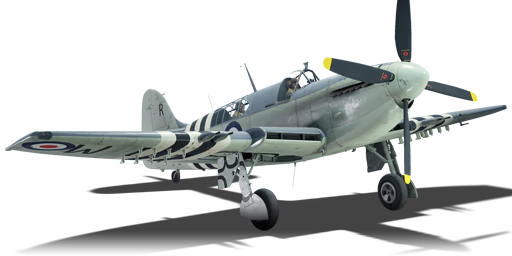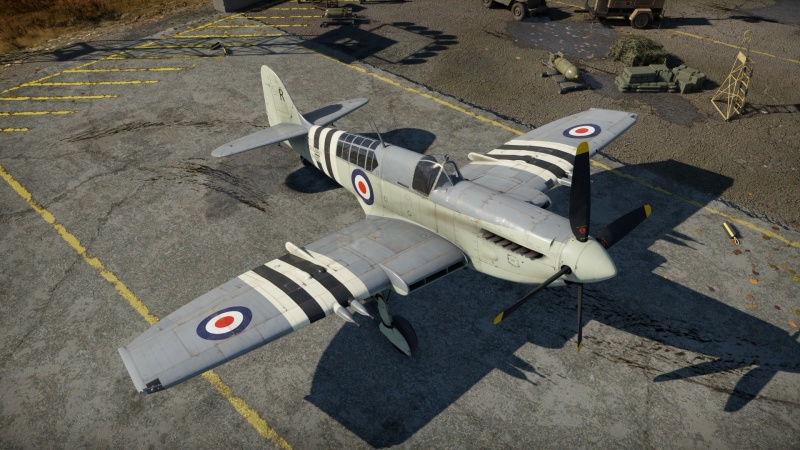Difference between revisions of "Firefly FR Mk V"
(→Details: Corrected flap rip speed) |
(Updated class) |
||
| Line 1: | Line 1: | ||
{{About | {{About | ||
| − | | about = British | + | | about = British strike aircraft '''{{PAGENAME}}''' |
| other | | other | ||
| usage-1 = the other version | | usage-1 = the other version | ||
| Line 14: | Line 14: | ||
== Description == | == Description == | ||
<!-- ''In the description, the first part should be about the history of and the creation and combat usage of the aircraft, as well as its key features. In the second part, tell the reader about the aircraft in the game. Insert a screenshot of the vehicle, so that if the novice player does not remember the vehicle by name, he will immediately understand what kind of vehicle the article is talking about.'' --> | <!-- ''In the description, the first part should be about the history of and the creation and combat usage of the aircraft, as well as its key features. In the second part, tell the reader about the aircraft in the game. Insert a screenshot of the vehicle, so that if the novice player does not remember the vehicle by name, he will immediately understand what kind of vehicle the article is talking about.'' --> | ||
| − | The '''{{Specs|name}}''' is a rank {{Specs|rank}} British | + | The '''{{Specs|name}}''' is a rank {{Specs|rank}} British strike aircraft {{Battle-rating}}. It was introduced in [[Update 1.49 "Weapons of Victory"]]. |
== General info == | == General info == | ||
| Line 194: | Line 194: | ||
{{AirManufacturer Fairey}} | {{AirManufacturer Fairey}} | ||
| − | {{Britain strike | + | {{Britain strike aircraft}} |
Revision as of 12:36, 11 March 2021
| This page is about the British strike aircraft Firefly FR Mk V. For the other version, see Firefly F Mk I. For other uses, see Firefly (Disambiguation). |
Contents
Description
The Firefly FR Mk V is a rank III British strike aircraft with a battle rating of 4.0 (AB/SB) and 3.7 (RB). It was introduced in Update 1.49 "Weapons of Victory".
General info
Flight performance
Describe how the aircraft behaves in the air. Speed, manoeuvrability, acceleration and allowable loads - these are the most important characteristics of the vehicle.
| Characteristics | Max Speed (km/h at 5,181 m) |
Max altitude (metres) |
Turn time (seconds) |
Rate of climb (metres/second) |
Take-off run (metres) | |||
|---|---|---|---|---|---|---|---|---|
| AB | RB | AB | RB | AB | RB | |||
| Stock | 522 | 503 | 10050 | 29.5 | 30.8 | 9.5 | 9.5 | 450 |
| Upgraded | 591 | 554 | 26.5 | 28.0 | 19.5 | 13.5 | ||
Details
| Features | ||||
|---|---|---|---|---|
| Combat flaps | Take-off flaps | Landing flaps | Air brakes | Arrestor gear |
| ✓ | ✓ | ✓ | X | ✓ |
| Limits | ||||||
|---|---|---|---|---|---|---|
| Wings (km/h) | Gear (km/h) | Flaps (km/h) | Max Static G | |||
| Combat | Take-off | Landing | + | - | ||
| 720 | 280 | 600 | 327 | 250 | ~10 | ~6 |
| Optimal velocities (km/h) | |||
|---|---|---|---|
| Ailerons | Rudder | Elevators | Radiator |
| < 321 | < 400 | < 410 | > 314 |
| Compressor (RB/SB) | ||
|---|---|---|
| Setting 1 | ||
| Optimal altitude | 100% Engine power | WEP Engine power |
| 2,400 m | 1,510 hp | 2,166 hp |
| Setting 2 | ||
| Optimal altitude | 100% Engine power | WEP Engine power |
| 6,400 m | 1,410 hp | 2,002 hp |
Survivability and armour
- 42.8 mm Bulletproof glass in cockpit front.
- 12.7 mm Steel plate behind the pilot.
Modifications and economy
Armaments
Offensive armament
The Firefly FR Mk V is armed with:
- 4 x 20 mm Hispano Mk.V cannons, wing-mounted (175 rpg outer + 145 rpg inner = 640 total)
Suspended armament
The Firefly FR Mk V can be outfitted with the following ordnance:
- Without load
- 2 x 1,000 lb M.C. 1,000 lb Mk.I bombs (2,000 lb total)
- 16 x RP-3 rockets
- 2 x 250 lb G.P. 250 lb Mk.IV bombs + 8 x RP-3 rockets (500 lb total)
- 2 x 500 lb G.P. 500 lb Mk.IV bombs + 8 x RP-3 rockets (1,000 lb total)
Usage in battles
Describe the tactics of playing in an aircraft, the features of using aircraft in a team and advice on tactics. Refrain from creating a "guide" - do not impose a single point of view, but instead, give the reader food for thought. Examine the most dangerous enemies and give recommendations on fighting them. If necessary, note the specifics of the game in different modes (AB, RB, SB).
Manual Engine Control
| MEC elements | ||||||
|---|---|---|---|---|---|---|
| Mixer | Pitch | Radiator | Supercharger | Turbocharger | ||
| Oil | Water | Type | ||||
| Controllable | Controllable Not auto controlled |
Not controllable Not auto controlled |
Controllable Auto control available |
Separate | Controllable 2 gears |
Not controllable |
Pros and cons
Pros:
- Faster than the Firefly Mk I with a better roll rate thanks to its more powerful engine and clipped wings
- One of the earliest planes with Hispano Mk.V cannons. Much larger ammo load with much less of a tendency to overheat than the Mk.II
- Same good bomb load but double the amount of rockets available to the pilot
- Has an interceptor spawn, which can be useful
Cons:
- Less manoeuvrable overall than the Firefly Mk I aside from the roll rate
- Somewhat large target for a single-engine fighter
- Still rather slow in comparison to other fighters at its rank
- Below average climb rate compared to Spitfires
History
Describe the history of the creation and combat usage of the aircraft in more detail than in the introduction. If the historical reference turns out to be too long, take it to a separate article, taking a link to the article about the vehicle and adding a block "/ History" (example: https://wiki.warthunder.com/(Vehicle-name)/History) and add a link to it here using the main template. Be sure to reference text and sources by using <ref></ref>, as well as adding them at the end of the article with <references />. This section may also include the vehicle's dev blog entry (if applicable) and the in-game encyclopedia description (under === In-game description ===, also if applicable).
In-game description
The Fairey Firefly had entered service in 1943 and served successfully in the closing stages of the Second World War as a multi-role, carrierborne fighter/strike aircraft. In 1944 a Rolls-Royce Griffon 72 was fitted to the Firefly for testing; the resulting improvements led to the Griffon 74 powered Firefly Mk.IV which entered service in 1947. The Mk.IV replaced the earlier three bladed propeller with a four bladed unit fitted to the new engine, and moved the radiators from the chin position to underneath the wings. The wings were also clipped to increase the roll rate. The leading edge of the tail fin was also extended and two under wing fairings carried fuel and a radar scanner in port and starboard respectively.
The Firefly Mk.V built on the success of the previous variant with further modifications. For specialized roles, sub variants of the Firefly included a number of internal changes for the standard day fighter/reconnaissance variant, night fighter and anti-submarine aircraft. Power folding wings were also introduced during the life of the Mk.V which greatly assisted the efficiency of deck operations.
812 Naval Air Squadron was the first front line unit to re-equip with the Mk.V, at Eglinton in July 1948. When the Korean People's Army crossed the 38th Parallel in June 1950, Korea was plunged into war and the carrierborne aircraft of the Fleet Air Arm were in action within days of the outbreak of hostilities. HMS Triumph was the first British carrier in theatre, but the embarked 827 NAS were actually still operating Second World War vintage Firefly Mk.Is. It was the Mk.V which replaced it in theatre which proved to be the most prolific variant of the conflict, being operated by 810, 812, 817, 821 and 825 Naval Air Squadrons. The Firefly was regularly engaged in strikes against key infrastructure such as bridges, railways, harbour installations and industrial sites. Operating in a range of conditions including sub-zero temperatures and storms, the Fireflies served alongside Seafires and Sea Furies to maintain an impressive rate of operations, proving to be resilient to the elements and the rigours of continued deck operations in anger. In 1952 a record-breaking day of operations was achieved from HMS Ocean when Fireflies and Sea Furies flew 123 sorties in a single day. Fireflies of 825 NAS were also involved in ground attack sorties during the 1954 Malayan Emergency.
Post-war, the Firefly served as an export aircraft with Canada, Australia, Denmark, the Netherlands, Ethiopia, Thailand, Sweden and India. The venerable aircraft left the service of the Fleet Air Arm in 1956, after 13 years of operations.
Media
Excellent additions to the article would be video guides, screenshots from the game, and photos.
See also
Links to the articles on the War Thunder Wiki that you think will be useful for the reader, for example:
- reference to the series of the aircraft;
- links to approximate analogues of other nations and research trees.
External links
| Fairey Aviation Company, Limited | |
|---|---|
| Fighters | Firefly F Mk I · Firefly FR Mk V |
| Bombers | Swordfish Mk I · Swordfish Mk II |
| Export | ◘Firefly F.Mk.IV |
| Britain strike aircraft | |
|---|---|
| Blackburn | Firebrand TF Mk IV · Firecrest |
| Bristol | Beaufighter Mk I (40-mm) · Beaufighter Mk VIc · Beaufighter Mk X · Beaufighter Mk 21 |
| CAC | ▄Wirraway |
| Fairey | Firefly F Mk I · Firefly FR Mk V |
| de Havilland | Mosquito FB Mk VI · Mosquito FB Mk XVIII |
| Hawker | Hurricane Mk IV · Tempest Mk V (Vickers P) |
| Westland | Wyvern S4 |





